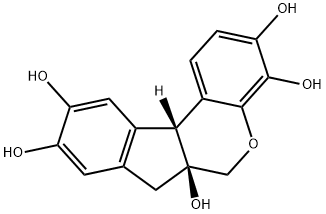A4695712
Hematoxylin , High -pure level,> 99%(HPLC) , 517-28-2
Synonym(s):
H&E Stain, Gill;Hematoxylin;Hematoxylin cryst. (C.I. 75290);Natural Black 1
CAS NO.:517-28-2
Empirical Formula: C16H14O6
Molecular Weight: 302.28
MDL number: MFCD00283323
EINECS: 208-237-3
| Pack Size | Price | Stock | Quantity |
| 1g | RMB45.60 | In Stock |
|
| 5G | RMB142.40 | In Stock |
|
| 25G | RMB528.00 | In Stock |
|
| 100G | RMB1839.20 | In Stock |
|
| others | Enquire |
Update time: 2022-07-08
PRODUCT Properties
| Melting point: | 200 °C (dec.)(lit.) |
| Boiling point: | 363.32°C (rough estimate) |
| Density | 1.2514 (rough estimate) |
| bulk density | 500kg/m3 |
| vapor pressure | 0-0Pa at 20-25℃ |
| refractive index | 1.4600 (estimate) |
| storage temp. | Keep in dark place,Inert atmosphere,Room temperature |
| solubility | Soluble in 95% ethanol(1 mg/mL). |
| form | Powder/Solid |
| Colour Index | 75290 |
| pka | 6.7(at 25℃) |
| color | Yellow to Brown |
| PH Range | Red (0.0) to yellow (1.0);Pale yellow (5.0) to violet (6.0) |
| Water Solubility | SOLUBLE IN HOT WATER |
| Sensitive | Light Sensitive |
| λmax | 292nm, 445nm, 560nm |
| Merck | 14,4637 |
| BRN | 91399 |
| Stability: | Stable, but may discolour on exposure to light. Incompatible with strong oxidizing agents. |
| Major Application | Plasma displays, textiles, hair dyes, identifying fresh and stale rice, diag-nosing cancer progression, detecting nosing cancer progression, cervical disease, central nervous system malfunctions, detecting genes, breast cancer, collagen in a tissue sample, apoptosis, demyelinating diseases, antigens, treatment of age-related macular degeneration, burns, prostate cancer, diabetesand obesity, viral diseases, neoplasms, peripheral neural and vascular ailments, skin disorders, biotechnological applications, reference standard materials for cytology, histology andimmunohistochemistry |
| InChIKey | WZUVPPKBWHMQCE-UHFFFAOYSA-N |
| LogP | 0.3 at 30℃ and pH6.9 |
| CAS DataBase Reference | 517-28-2 |
| EPA Substance Registry System | Hematoxylin (517-28-2) |
Description and Uses
Hematoxylin and eosin together make up Hematoxylin and eosin stain, one of the most commonly used stains in histology. Metal-haematein complexes are used to stain cell nuclei prior to examination under a microscope. Structures that stain with iron- or aluminum-haematein are often called basophilic, even though the mechanism of the staining is different from that of staining with basic dyes.
Safety
| Symbol(GHS) |  GHS07 |
| Signal word | Warning |
| Hazard statements | H319 |
| Precautionary statements | P264-P280-P305+P351+P338-P337+P313 |
| Hazard Codes | Xn,Xi |
| Risk Statements | 22-36/37/38 |
| Safety Statements | 26-36 |
| WGK Germany | 2 |
| RTECS | MH7875000 |
| TSCA | Yes |
| HS Code | 32030019 |
| Hazardous Substances Data | 517-28-2(Hazardous Substances Data) |



